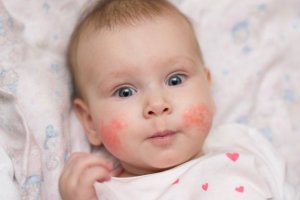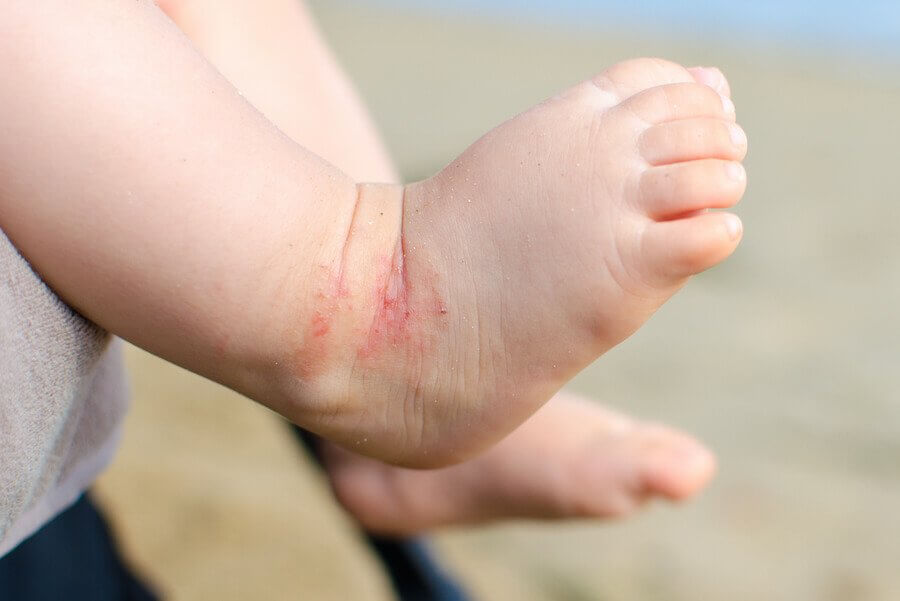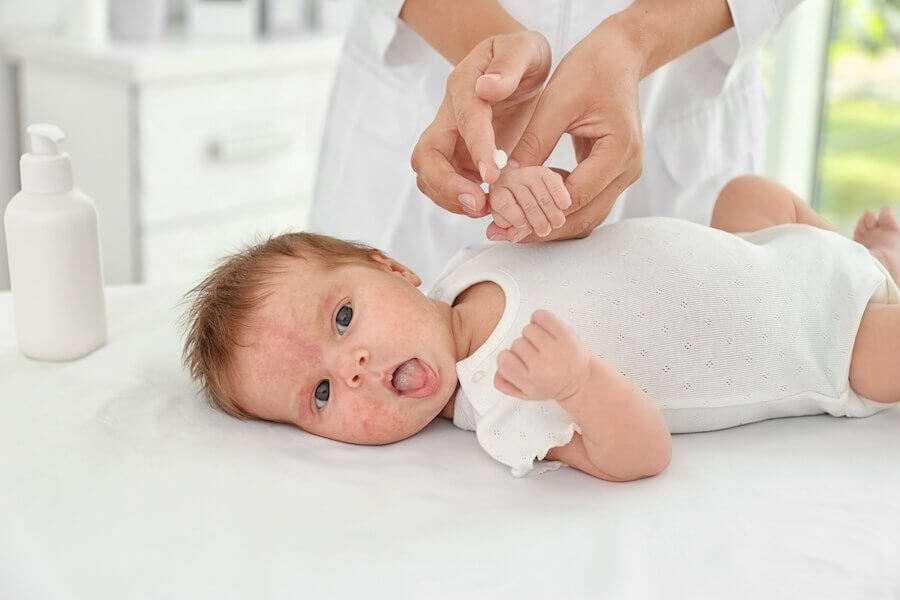Eczema in Children: How to Prevent Outbreaks

Eczema is a skin condition that affects about 20% of children in their first years of life. It’s a very common disease that stays for several years, disappearing as they grow. Learn how to prevent outbreaks of eczema in children below.
Identifying eczema in children
Symptoms
You can identify eczema through redness on the skin, itching, pain and swelling in the affected area, and pus, among other symptoms. Therefore, identifying the start of an outbreak and applying special creams can prevent the symptoms from getting worse.
Age of appearance
This disease affects all skin types, and usually appears at a very young age. However, it looks different in babies and children. Generally, it affects the face, head, hands, and the folds of elbows and knees.
The Integral Pediatrics health portal explains the following: “In 60% of patients, it begins in the first year of life, mainly in the first 6 months. In 85%, in the first 5 years and only 10% develop the disease after 7 years.”
Therefore, in babies, it occurs after 3 or 4 months. The skin problems usually appear on their cheeks, head and limbs. Some mothers confuse diaper rash with eczema. However, eczema doesn’t occur in areas that are constantly wet.

In childhood, it can appear after 2 years, where you’ll see it on the neck, hands, ankles, elbow folds, and buttocks. In white children, rashes usually show up on the internal folds. However, in Asian and Afro-descendant children, it usually appears on the elbows and knees.
It’s important to point out that eczema appears through three stages: infant, child and adult.
How eczema occurs according to its phases
Eczema has two phases:
- Inactive. The skin becomes very dry and scaly, as well as sensitive. During this period, you can use preventative measures to stop it from getting worse. As we mentioned before, keep the affected area hydrated with special creams and moisturizers.
- Active. Inflammations are more intense, and pus and bleeding from scratching is common. In addition, the skin can become inflamed and harden.
How to prevent outbreaks of eczema in children
Triggers
To prevent outbreaks of eczema in children, it’s important to know what triggers it. Let’s start by saying that this disease isn’t contagious.
Going back to the Integral Pediatrics health portal, they point out that “in 70-80% of children, there’s a family or personal history of skin conditions.” Therefore, it’s important to take genetic factors into account.
Factors that contribute to eczema in children are:
- Dry skin
- Use of creams with chemicals that cause irritation
- Herpes and fungi
- Contact with allergens, pollen, dust, animal hair, food poisoning, etc.
- Contact with fabrics that have been washed with abrasive detergents and using synthetic fabrics such as nylon, wool or viscose.
The clinical manifestations of eczema are the basis of its diagnosis, since there are no specific microscopic or laboratory changes.
–M. Ridao i Redondo, Pediatrician–

Prevention strategies
Nowadays, you can use corticosteroids and antibiotics to control outbreaks of eczema in children. However, your doctor will determine the causes of your child’s eczema and choose the best option for him.
Therefore, these are some actions that are aimed at preventing symptoms:
- Control the temperature: avoid excessive heat
- Maintain a significant level of humidity in the area where your child is
- Provide short, refreshing baths to stop sweating, with water that’s not too hot
- Do the baths with acidic pH soap without detergent
- Pat to dry without rubbing
- Avoid using clothes made out of irritating material
- Apply cream or moisturizer daily
- Avoid scratching by cutting your child’s nails properly
- Avoid swimming in pools due to the high amount of chlorine they contain
The Spanish Association of Pediatrics recommends taking the following measures: “Decrease contact with acidic foods (tomatoes, citrus, etc). Frequently change diapers and be careful when washing clothing.”
Remember, if you have any concerns, you should alway consult your pediatrician or dermatologist. That way, you’ll get the proper guidance you need to treat your child’s needs.
Eczema is a skin condition that affects about 20% of children in their first years of life. It’s a very common disease that stays for several years, disappearing as they grow. Learn how to prevent outbreaks of eczema in children below.
Identifying eczema in children
Symptoms
You can identify eczema through redness on the skin, itching, pain and swelling in the affected area, and pus, among other symptoms. Therefore, identifying the start of an outbreak and applying special creams can prevent the symptoms from getting worse.
Age of appearance
This disease affects all skin types, and usually appears at a very young age. However, it looks different in babies and children. Generally, it affects the face, head, hands, and the folds of elbows and knees.
The Integral Pediatrics health portal explains the following: “In 60% of patients, it begins in the first year of life, mainly in the first 6 months. In 85%, in the first 5 years and only 10% develop the disease after 7 years.”
Therefore, in babies, it occurs after 3 or 4 months. The skin problems usually appear on their cheeks, head and limbs. Some mothers confuse diaper rash with eczema. However, eczema doesn’t occur in areas that are constantly wet.

In childhood, it can appear after 2 years, where you’ll see it on the neck, hands, ankles, elbow folds, and buttocks. In white children, rashes usually show up on the internal folds. However, in Asian and Afro-descendant children, it usually appears on the elbows and knees.
It’s important to point out that eczema appears through three stages: infant, child and adult.
How eczema occurs according to its phases
Eczema has two phases:
- Inactive. The skin becomes very dry and scaly, as well as sensitive. During this period, you can use preventative measures to stop it from getting worse. As we mentioned before, keep the affected area hydrated with special creams and moisturizers.
- Active. Inflammations are more intense, and pus and bleeding from scratching is common. In addition, the skin can become inflamed and harden.
How to prevent outbreaks of eczema in children
Triggers
To prevent outbreaks of eczema in children, it’s important to know what triggers it. Let’s start by saying that this disease isn’t contagious.
Going back to the Integral Pediatrics health portal, they point out that “in 70-80% of children, there’s a family or personal history of skin conditions.” Therefore, it’s important to take genetic factors into account.
Factors that contribute to eczema in children are:
- Dry skin
- Use of creams with chemicals that cause irritation
- Herpes and fungi
- Contact with allergens, pollen, dust, animal hair, food poisoning, etc.
- Contact with fabrics that have been washed with abrasive detergents and using synthetic fabrics such as nylon, wool or viscose.
The clinical manifestations of eczema are the basis of its diagnosis, since there are no specific microscopic or laboratory changes.
–M. Ridao i Redondo, Pediatrician–

Prevention strategies
Nowadays, you can use corticosteroids and antibiotics to control outbreaks of eczema in children. However, your doctor will determine the causes of your child’s eczema and choose the best option for him.
Therefore, these are some actions that are aimed at preventing symptoms:
- Control the temperature: avoid excessive heat
- Maintain a significant level of humidity in the area where your child is
- Provide short, refreshing baths to stop sweating, with water that’s not too hot
- Do the baths with acidic pH soap without detergent
- Pat to dry without rubbing
- Avoid using clothes made out of irritating material
- Apply cream or moisturizer daily
- Avoid scratching by cutting your child’s nails properly
- Avoid swimming in pools due to the high amount of chlorine they contain
The Spanish Association of Pediatrics recommends taking the following measures: “Decrease contact with acidic foods (tomatoes, citrus, etc). Frequently change diapers and be careful when washing clothing.”
Remember, if you have any concerns, you should alway consult your pediatrician or dermatologist. That way, you’ll get the proper guidance you need to treat your child’s needs.
All cited sources were thoroughly reviewed by our team to ensure their quality, reliability, currency, and validity. The bibliography of this article was considered reliable and of academic or scientific accuracy.
- Ruiz-Canela Cáceres J, Bernabéu Wittel J. Guía de Algoritmos en Pediatría de Atención Primaria. Dermatitis atópica. AEPap. 2015 (en línea). Disponible en algoritmos.aepap.org
- Mateos, M. (2011). Guía de tratamiento de la Dermatitis Atópica en el niño. Documento de consenso grupo de expertos. https://doi.org/10.1130/B30336.1
- Zambrano, A. Z. (1997). Dermatitis atopica. Pediatria Integral. https://doi.org/10.1016/S1761-2896(16)80892-4
- Fonseca, E. Dermatitis atópica. Asociación Española de Pediatría. https://www.aeped.es/sites/default/files/documentos/dermatopica.pdf
This text is provided for informational purposes only and does not replace consultation with a professional. If in doubt, consult your specialist.








